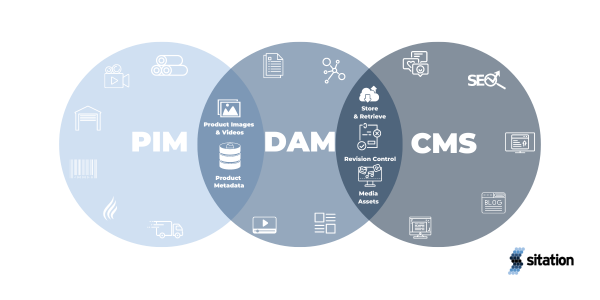By Sitation Account Executive, Ian Wills
PIM vs DAM vs CMS
PIM, DAM, and CMS are all software solutions used for managing digital content, but they serve different purposes and are applied to different types of content.
Product Information Management (PIM)
PIM is a process of managing and enriching the product information of an organization, which includes all the attributes, descriptions, and images of the products that the organization offers. The goal of PIM is to ensure that the product information is consistent, accurate, and complete across all channels, including e-commerce websites, mobile apps, and in-store displays. PIM solutions typically provide centralized tools for managing product information, as well as workflows for managing product updates and approvals.
Digital Asset Management (DAM)
DAM is a software solution used to manage digital assets, such as photos, videos, audio files, and other rich media assets. DAM solutions typically offer tools for organizing, cataloging, searching, and sharing digital assets, and provide workflows for managing the asset lifecycle. DAM platforms are commonly used by marketing teams, publishers, and creative agencies to manage and distribute digital assets.
Content Management Systems (CMS)
CMS are software systems designed to create, manage and publish content on websites. CMS solutions typically offer tools for content creation, editing, collaboration, and publishing, and provide workflows for managing the content lifecycle. CMS platforms are commonly used for managing web pages, blog posts, news articles, and other similar types of content.
While all three solutions can store and manage digital content, they differ in terms of their focus and capabilities. DAM is focused on managing digital assets, such as images and videos, while PIM is focused on managing product information, such as descriptions, attributes, and prices, and CMS is focused on managing website content, such as web pages, blog posts, and news articles. However, there may be some overlap between the three solutions, as digital assets and product information are often used within website content.

What should I consider when selecting a PIM, DAM, and CMS?
When selecting a PIM, DAM, and CMS there are several factors that you should consider. Here are some important considerations:
1. Business goals and requirements
Consider your organization’s specific business goals and requirements. What types of content or products do you need to manage? What are the key features and functionalities that you need in a system to meet your business needs?
2. User experience and usability
Look for a solution that is user-friendly and intuitive to use. The system should have a clear and well-designed interface that allows users to easily manage and access content.
3. Scalability and flexibility
Consider whether the system can grow and adapt with your organization over time. Look for a system that can handle increasing volumes of content or products, as well as new or changing business requirements.
4. Integration capabilities
Consider how the system integrates with other software solutions that your organization is already using, such as ERP systems or marketing automation tools. Look for a system that offers robust integration capabilities to ensure seamless data flow between systems.
5. Security and compliance
Look for a system that offers strong security features to protect your content or products, as well as compliance with industry regulations or standards.
6. Support and training
Consider the level of support and training that the vendor offers. Look for a vendor that provides comprehensive training resources and support services to help your team learn the system and troubleshoot any issues that may arise.
7. Total cost of ownership
Consider the total cost of ownership of the system, including the upfront costs, ongoing maintenance and support fees, and any potential costs for customization or integration. Look for a system that offers a reasonable total cost of ownership that aligns with your organization’s budget and resources.
Contact the experts at Sitation to further understand which solutions meet your goals and integrate with your existing platform instances.